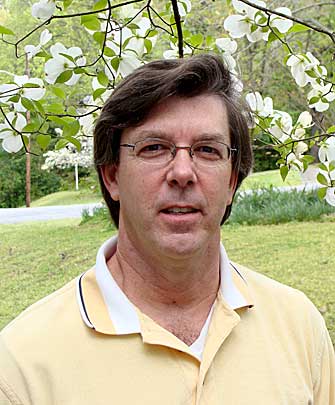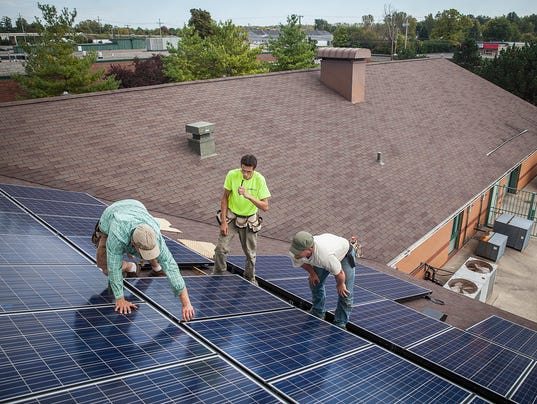A wolf pack of in-state utilities and out-of-state petrochemical billionaires has attacked Ohio's clean energy law, threatening to kill clean jobs and wreak further damage on the environment.
This attack is led by Ohio state Senator Bill Seitz (R), who five years earlier voted for the law, but after accepting dirty energy money compared the law to Stalinism. The latest step to stall and dismantle clean energy incentives is the so-called "Energy Mandates Study Committee," or "EMSC." The EMSC was established after previous failed attempts by Sen. Seitz and other Ohio Senators to repeal or weaken the clean energy law.
The EMSC's recent decision to indefinitely stall laws promoting clean, efficient energy and the jobs they produce, is a power grab by coal utilities paying dropping campaign contributions in exchange to the gutting pollution-free clean energy jobs in Ohio.
A review of Ohio campaign finance data reveals some of the money behind these politicians' attack on successful clean energy incentives:
Quid Pro Coal: Dirty Energy funding to Ohio politicians on the "Energy Mandates Study Committee"
Data courtesy The National Institute on Money in State Politics - FollowTheMoney.org
Ohio Politician
|
ALEC?
|
Utility Industry
|
Coal Mining
|
Oil & Gas
|
TOTAL
|
| Rep. Ron Anstutz |
X |
$83,100 |
$35,200 |
$90,686 |
$208,986 |
| Sen. Bill Seitz |
X |
$79,125 |
$25,350 |
$20,425 |
$124,900 |
| Sen. Cliff Hite |
X |
$50,085 |
$2,990 |
$64,855 |
$117,950 |
| Rep. Kristina Roegner |
X |
$62,950 |
$2,150 |
$28,400 |
$93,500 |
| Sen. Troy Balderson |
X |
$43,400 |
$2,450 |
$30,200 |
$76,050 |
| Sen. Bob Peterson |
|
$31,650 |
$3,600 |
$14,850 |
$50,100 |
| Rep. Christina Hagan |
X |
$24,280 |
$2,050 |
$21,900 |
$48,230 |
| Rep. Louis W. Blessing, III |
X |
$37,578 |
$1,200 |
$3,350 |
$42,128 |
| Rep. Jack Cera |
|
$11,000 |
$1,350 |
$9,200 |
$21,550 |
| Rep. Mike Stinziano |
|
$16,150 |
$0 |
$2,700 |
$18,850 |
| Sen. Sandra Williams |
|
$14,700 |
$500 |
$250 |
$15,450 |
| Sen. Capri Cafaro |
|
$12,200 |
$1,000 |
$0 |
$13,200 |
GRAND TOTAL
|
|
$466,218
|
$77,840
|
$286,816
|
$830,874
|
ALEC, Clean Energy, and Rigged Markets
The EMSC is stacked with politicians linked to the American Legislative Exchange Council (ALEC), the corporate bill-mill whose state legislator members help dirty energy lobbyists forge laws rolling back clean energy incentives. Some of ALEC's top "private sector members" include Koch Industries, ExxonMobil, Peabody, and Duke Energy.
At recent ALEC meetings, many of these companies sent their lobbyists to rub elbows with state politicians and create template laws in meetings closed to the public. ALEC facilitated the creation of several model bills intended to trip up the booming clean energy industry.
Legislators violate ALEC's core mission of promoting "free markets," giving their fossil fuel sponsors a pass and attacking incentives for their clean competitors at the expense of human health, clean air, clean water and a stable climate. ALEC's cookie-cutter attacks on clean energy have taken various shapes in Ohio, North Carolina, Kansas and a dozen other states.
Quid Pro Coal - What Lobbying Looks Like
Public emails recently published by Energy & Policy Institute show Sen. Seitz recruited help from utility lobbyists as he crafted SB 58.
The utilities gave the bulk of $466,218 to 12 politicians on Sen. Seitz's committee, documented above. This includes companies directly coordinating with Sen. Seitz, according to his emails.
Ohio utility companies -- FirstEnergy, American Electric Power, Duke Energy, NiSource, AES subsidiary Dayton Power & Light, and the Ohio Rural Electric Cooperatives (OREC) -- were directly solicited for input on Seitz's clean energy freeze bill, SB 58, a placeholder bill that preceded Sen. Seitz's study committee. See thistimeline, courtesy of Energy & Policy Institute.
Ohio Rural Electric Cooperatives is part of a massive consortium of smaller-scale electric co-ops called the National Rural Electric Cooperative Association (NRECA). NRECA is the top contribution to national politicians among all dirty energy interests, even outspending Koch Industries PAC. NRECA's Ohio affiliate gave Sen. Seitz $4,250 in 2012. The next year, OREC lobbyists helped write Sen. Seitz's bill, SB 58, telling a Seitz staffer, "As we discussed,nbsp;attached is suggested language for inclusion in SB 58 with slight modifications."
No such opportunities were provided to clean energy advocates in communication with Sen. Seitz, including several small businesses, the Sierra Club and affiliates of unions like the Steelworkers and AFL-CIO.
Seitz repeatedly dismissed an Ohio State University study, commissioned by Ohio Advanced Energy Economy (OAEE), a group of Ohio businesses advocating for clean energy in Ohio. OAEE President Ted Ford warned Senator Seitz in a letter:
"[W]e can report that the results [of SB 58] are worse for ratepayers than we initially thought. The Ohio State University Study (version 2.0) finds that the bill is a massive giveaway to Ohio utilities, and would cost consumers almost $4 billion between now and 2025. The study also finds the standards have already saved Ohioans 1.4% on their electric bills."
A handwritten note on the letter, apparently written by Senator Seitz, says "more complete fabrications from people with zero credibility." The letter and handwritten commentary were circulated by a Seitz staffer to lobbyists at Duke Energy, American Electric Power, First Energy and others.
Seitz shot back a letter to OAEE and the Ohio Sierra Club, loaded with questions attacking the credibility and relevance of their data, also sourced from the Ohio State University Study.
It turns out, Sen. Seitz prefers his data from out-of-state universities, financed by none other than Kansas billionaire Charles Koch.
Koch University, Inc. - Utah State University
Ohio's coal-burning utilities aren't the only interests helping Seitz behind the scenes. The ALEC senator's study committee relied on data using dishonest measurements from professors at Utah State University (USU) in a department that has taken over$1.6 million from Charles Koch since 2005. USU is among the Charles Koch Foundation's top-funded universities.
It begs the question: Why would Ohio politicians look to Utah professors, financed by a Kansas billionaire, for the data on Ohio's clean energy and efficiency efforts?
The Koch-funded Institute for Political Economy at USU has produced a series of reports that give politicians the bad data needed to attack clean energy. The Koch professors are USU, like the Suffolk professors before them, appear to be intentionally misleading. Foundations affiliated with Koch Industries have backed these Utah professors in identical attacks on renewable energy standards, in Kansas and North Carolina.
Disproved data aside, USU professor Randy Simmons hid his financial conflicts of interest in a national op-ed for Newsweek.
These aren't the only Koch-funded professors stepping up to the plate to bat against wind. Before Utah, it was the Koch-funded Beacon Hill Institute at Suffolk University. And recently, Kansas University Professor Art Hall was caught taking payments from Koch to study the Kansas renewable energy standard, not long before he told the Kansas legislature to erode the incentives. Hall's previous job: Koch Industries' chief economist.
Koch Industries' executives are pushing "fake it till you make it" into the unknown.
Why the Freeze Makes Zero Sense
It's not the affiliations that matter so much as the false data and backwards hype involved.
The American Wind Energy Association (AWEA), the U.S. wind energy trade association, has revealed basic flaws in all three of these Koch-funded professors' reports out of Utah State University. AWEA's Michael Goggin:
Instead of only going back to EIA’s 2013 renewable cost estimates like they did in their Kansas report, in their Ohio report they go back to 2008 cost data to develop their estimate of how the cost of wind energy compares against alternatives.
No explanation is provided for why they did not use EIA’s more recent 2015 and 2014 data, which show that wind energy imposes no net cost relative to conventional sources of energy even after removing the impact of federal incentives. Of course, the authors could have also used recent data from real-world market prices and found that wind energy provides significant net benefits for consumers, as we did above. Instead, using obsolete data allows them to miss how the cost of wind energy has fallen by more than half over the last five years, as documented by both government and private investor data.
Jobs, lower energy bills, less wasted energy...frozen by Senator Seitz
Samantha Williams at Natural Resources Defense Council surveys the data that Senator Seitz refuses to accept:
As of 2013, Ohio was home to over 400 advanced energy companies that employed over 25,000 Ohioans and was leading the country in the number of facilities manufacturing components for wind technology and second in the number of solar equipment providers. A report by the Pew Charitable trusts shows Ohio attracted $1.3 billion in private clean energy investment from 2009 to 2013. Similarly, Environmental Entrepreneurs (E2) reported that, just prior to the passage of the SB 310 clean energy freeze, Ohio's clean tech economy had grown to support 89,000 jobs.
Unfortunately, much of that hard-earned momentum was a casualty of the freeze as well as HB 483, which basically tripled setbacks for wind turbines and made future commercial-scale development unviable.The renewable sector is particularly lagging, in the E2 report showing a scant 1.5 percent job growth in Ohio far lower than the national wind and solar rate.
Pancake Politics: They Liked this Law in 2008
Sen. Seitz voted along with a large majority of Ohio lawmakers in 2008 to pass the clean energy law. Five years later, Seitz was comparing the clean energy law to "Joseph Stalin's five-year Plan."
Ohio is in the midst of a fossil-fueled flip-flop.







